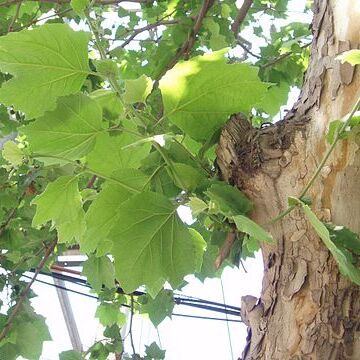Trees , deciduous, to 50 m. Trunks 1-several, erect to prostrate. Bark smooth at first, exfoliating in thin plates, exposing conspicuous mosaic of chalky white to buff or greenish new bark, becoming dark, thick, and fissured with age. Axillary buds: each hidden by swollen base of petiole. Leaves alternate, simple; stipules sometimes persisting, green, prominent, sheathing stem, flaring, margins entire to serrate. Leaf blade palmately (0-)3-7-lobed, base cordate, truncate, or cuneate; surfaces tomentose or glabrescent. Inflorescences axillary, solitary, appearing with leaves; staminate inflorescences with heads soon falling, 1-5, green, sessile, globose; pistillate with heads 1-7, terminal (and in some species lateral), sessile or pedunculate, globose, the whole much elongate and pendulous in fruit. Flowers unisexual, staminate and pistillate on same plants, very crowded, 3-4(-8)-merous, inconspicuous; perianth hypogynous, minute. Achenes maturing in fall, often persisting until spring, tan, club-shaped, quadrangular, with terminal stylar beak, surrounded by numerous hairs; hairs basally attached, thin, unbranched, 2/3 to nearly equal to length of achene.
Trees to 30–50 m high, monoecious, deciduous, with leaves, young stems and inflorescences densely dendritic-tomentose; wind-pollinated. Leaves alternate, stipulate, petiolate; petiole swollen at base, enclosing young bud; lamina simple, palmately lobed or palmatisect, with margins often coarsely toothed. Flowers borne in dense unisexual globose clusters sessile on elongate axes, small, 3–4 (–8)-merous; perianth in 2 whorls, hypogynous, minute, distinct or basally connate. Staminate flowers with tiny or vestigial sepals and petals; sometimes with vestigial carpels; stamens as many as and opposite petals, subsessile; anthers opening by lateral slits; connective with a terminal peltate appendage. Pistillate flowers often with 3 or 4 staminodes; carpels (3–) 5–8 (–9), free, in 2 or 3 whorls, imperfectly closed, with style terminal and stigma extending onto apex of carpel; ovules 1 (rarely 2) per carpel, pendulous, orthotropous or slightly hemitropous, bitegmic, crassinucellar. Fruits small, hairy achenes or nutlets, borne in globular clusters on elongate axes; seeds with thin testa, scanty endosperm.

